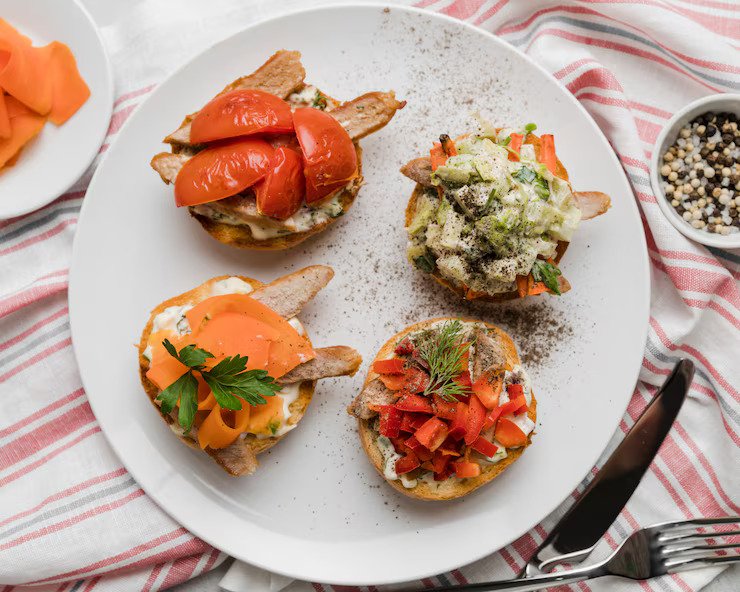Luxembourg, a small yet culturally rich country, offers a unique culinary experience deeply rooted in its French, German, and Belgian heritage. The nation’s cuisine is characterized by its hearty and flavorful dishes, which have been influenced by the surrounding regions throughout history. This blend of cultures has resulted in a gastronomy that is both comforting and distinctively Luxembourgish.
One of the standout dishes that epitomizes Luxembourg’s robust culinary tradition is judd mat gaardebounen. This dish features smoked pork, typically neck or collar, paired with broad beans. The combination creates a savory and satisfying meal that embodies the essence of Luxembourg’s traditional cooking. The smoked meat, rich in flavor, complements the earthiness of the broad beans, making this dish a favorite among locals and visitors alike.
Another dish that holds a special place in Luxembourg’s culinary repertoire is the beloved gromperekichelcher. These potato fritters are seasoned with herbs and spices, then fried to golden perfection. Crispy on the outside and tender on the inside, gromperekichelcher are commonly enjoyed as a snack or a side dish. They are often served at markets and festivals, showcasing their popularity and cultural significance.
For those with a penchant for sweets, the quetschentaart offers a delightful conclusion to any meal. This traditional plum tart is made with ripe, juicy plums arranged over a buttery pastry base. The tartness of the plums is balanced by the sweetness of the pastry, creating a dessert that is as pleasing to the palate as it is to the eye. Quetschentaart is a seasonal treat, typically enjoyed in late summer and early autumn when plums are at their peak.
No exploration of Luxembourg’s cuisine would be complete without mentioning bouneschlupp, a comforting green bean soup. This dish combines green beans, potatoes, and bacon in a creamy broth, creating a warming and hearty soup that is perfect for cooler days. Bouneschlupp reflects the resourceful nature of Luxembourgish cooking, utilizing simple, readily available ingredients to create something truly satisfying.
These traditional dishes are just a few examples of Luxembourg’s rich culinary heritage, offering a window into the country’s history and cultural influences. Whether you are savoring a bowl of bouneschlupp on a chilly day or enjoying a slice of quetschentaart in the summer sun, Luxembourg’s cuisine provides a delicious journey through the flavors and traditions of this charming European nation.
What Food is Luxembourg Famous For? Traditional Luxembourg Dishes
Luxembourg’s culinary scene is a reflection of its rich cultural tapestry and its geographical position at the crossroads of Europe. The nation’s traditional dishes showcase an innovative use of seasonal local produce combined with time-honored preparation methods, resulting in hearty meals that provide a true taste of the region. Among the most celebrated dishes, Judd mat Gaardebounen stands out as a quintessential Luxembourgish specialty. This dish pairs tender smoked pork neck with broad beans, creating a savory combination that is both satisfying and deeply rooted in local tradition. The smokiness of the pork complements the earthy flavor of the beans, making it a beloved staple in Luxembourg homes.
Another noteworthy dish is Gromperekichelcher, which are crispy potato fritters that perfectly highlight Luxembourg’s agricultural heritage. These golden delicacies are seasoned with onions, parsley, and nutmeg, then fried to perfection. They are often enjoyed as a snack or side dish, offering a comforting crunch with every bite. The simplicity of the ingredients allows the natural flavors to shine, making Gromperekichelcher a must-try for anyone visiting the country.
Sweet Indulgence
Luxembourg’s culinary repertoire also includes delightful desserts, with Quetschentaart being a particular favorite. This local plum tart is a celebration of the region’s fruit harvest, featuring a buttery crust filled with sweet, juicy plums. The tarts are often baked to a golden hue, with the natural sweetness of the fruit providing a perfect balance to the flaky pastry. Enjoyed with a cup of coffee, Quetschentaart is a perfect example of Luxembourg’s ability to transform simple ingredients into a sumptuous treat.
Soup as a Staple
No exploration of Luxembourgish cuisine would be complete without mentioning Bouneschlupp, a hearty green bean soup that finds its way to many dining tables across the country. Often enriched with potatoes, carrots, and bacon, this soup is a wholesome offering that embodies the essence of Luxembourg’s culinary philosophy: using fresh, local ingredients to create nourishing and flavorful dishes. Bouneschlupp is especially popular during the colder months, providing warmth and comfort with every spoonful.
The Charm of Judd mat Gaardebounen: A Pork and Beans Delight
Luxembourg is renowned for its robust culinary offerings, a testament to its rich blend of French, German, and Belgian influences. Among the country’s traditional dishes, Judd mat Gaardebounen stands out as an iconic representation of Luxembourg’s gastronomic heritage. This flavorful dish combines smoked pork collar with broad beans, creating a meal that is both satisfying and reflective of the region’s culinary traditions.
The preparation of Judd mat Gaardebounen is deeply rooted in seasonal practices, taking advantage of local produce. The smoked pork, or Judd, is typically cured and simmered until tender, allowing the flavors to fully develop. This method not only enhances the taste but also reflects the traditional cooking techniques passed down through generations. The broad beans, or Gaardebounen, are a staple in Luxembourg’s agricultural landscape and are often harvested fresh from local fields, contributing a vibrant texture and a slightly nutty flavor to the dish.
The presentation of Judd mat Gaardebounen is as important as its preparation. The pork is usually served in thick, juicy slices, accompanied by a generous portion of broad beans. This pairing is not only visually appealing but also offers a delightful contrast of textures and flavors. For those eager to experience the full range of Luxembourg’s culinary delights, Judd mat Gaardebounen is often complemented with other local specialties such as Gromperekichelcher–crispy potato fritters that add a satisfying crunch, and Quetschentaart–a local plum tart that provides a sweet finish to the meal.
Preparation and Enjoyment
To fully appreciate Judd mat Gaardebounen, it is best savored alongside a glass of local wine or beer, which enhances the rich flavors of the pork and beans. The experience is a culinary journey through Luxembourg’s history, allowing diners to connect with the country’s agricultural roots and traditional cooking methods. Whether enjoyed in a cozy Luxembourgish bistro or prepared at home using authentic recipes, Judd mat Gaardebounen offers a glimpse into the heart of Luxembourg’s culinary identity.
Discovering the Rustic Appeal of Bouneschlupp: Luxembourg’s Hearty Bean Soup
In the culinary world of Luxembourg, the bouneschlupp stands out as a quintessential dish that embodies the region’s penchant for hearty, comforting fare. This traditional green bean soup is more than just a warming bowl; it is a reflection of Luxembourg’s agricultural roots and dedication to using local, seasonal produce. The bouneschlupp is composed of fresh green beans, potatoes, and savory bacon, simmered together to create a richly flavored broth that is both satisfying and nourishing. Often accompanied by gromperekichelcher, crispy potato fritters that add a delightful textural contrast, this dish showcases the simplicity and depth of Luxembourg’s culinary tradition.
The Ingredients that Define Bouneschlupp
What makes bouneschlupp particularly special is its reliance on fresh, local ingredients. Green beans, harvested at their peak, provide a vibrant base, while potatoes add body and substance to the soup. The inclusion of bacon or smoked pork harks back to the traditional methods of preserving meat, adding a smoky depth that enhances the overall flavor profile. These ingredients are not just staples in bouneschlupp but are also central to other Luxembourgish dishes, such as judd mat gaardebounen, where smoked pork is paired with broad beans.
A Tradition of Seasonal Cooking
Luxembourg’s culinary identity is deeply intertwined with its agricultural practices, with dishes like bouneschlupp celebrating the bounty of local farms. The emphasis on seasonal produce means that each bowl of soup is a testament to the changing seasons, offering a unique taste experience. Traditional preparation methods, passed down through generations, ensure that the flavors remain authentic and true to the region’s heritage. This connection to the land is echoed in other local favorites, such as quetschentaart, a plum tart that highlights the sweet, juicy plums that ripen in late summer.
For those seeking to explore the rich flavors of Luxembourg, bouneschlupp offers a perfect introduction. It is a dish that invites diners to appreciate the simplicity and depth of flavor that comes from careful preparation and quality ingredients. As you savor each spoonful, you’ll gain a deeper appreciation for the traditions that have shaped Luxembourg’s culinary landscape.
Exploring the Sweet Side: The Secret to Luxembourg’s Delicious Quetschentaart
Luxembourg is famous for hearty dishes that reflect its French, German, and Belgian heritage, with offerings like gromperekichelcher potato fritters and the celebrated quetschentaart, a local plum tart. The culinary landscape here is rich with flavors that draw from seasonal local produce and time-honored preparation methods, exemplified by dishes such as judd mat gaardebounen, which combines smoked pork with broad beans. However, among these savory delights, the quetschentaart stands out for its unique blend of simplicity and traditional craftsmanship.
The quetschentaart is more than just a dessert; it is a reflection of Luxembourg’s pastoral charm and agricultural traditions. This tart is typically made in early autumn when the plum trees, abundant in the region, yield their ripe, juicy fruit. The process begins with selecting the finest local plums, which are then meticulously arranged atop a buttery, flaky pastry crust. The sweetness of the plums is often complemented by a hint of cinnamon or vanilla, offering a warm, comforting aroma that fills the kitchen.
Preparation of quetschentaart requires patience and skill, as the dough must be chilled and rolled to perfection to achieve the right balance of texture and flavor. The plums, tender and slightly tart, caramelize beautifully as they bake, creating a luscious filling that contrasts with the crisp crust. This harmonious blend of textures and flavors is what makes the quetschentaart a beloved staple in Luxembourg’s culinary repertoire.
For those eager to recreate this Luxembourgish classic at home, the key lies in the quality of ingredients. Using fresh, seasonal plums will not only enhance the flavor but also celebrate the region’s agricultural bounty. Additionally, ensuring the pastry is well-chilled before baking is crucial to achieving the desired flaky texture. When served slightly warm, perhaps with a dollop of whipped cream or a scoop of vanilla ice cream, the quetschentaart offers a taste of Luxembourg’s rich culinary heritage, inviting all who partake to savor the essence of this small yet vibrant country.
Unveiling the Unique Flavors of Friture de la Moselle: Fried Fish from the Moselle River
Luxembourg’s culinary scene is a rich tapestry of flavors, drawing from its French, German, and Belgian neighbors. Among its many traditional dishes, Friture de la Moselle stands out as a distinctive representation of regional ingredients and cooking styles. This delicacy primarily features the small fish native to the Moselle River, which are meticulously prepared and fried to perfection. The fish, typically gudgeon, perch, and sometimes eel, are lightly battered to preserve their natural taste and are served hot, offering a delightful crunch with each bite.
The preparation of Friture de la Moselle is as much an art as it is a culinary tradition. The key lies in the freshness of the catch, with local fishmongers ensuring that only the best specimens make it to the plate. These fish are cleaned and coated in a delicate mixture, often comprising flour and a touch of cornmeal for texture, before being immersed in hot oil until golden brown. It’s a dish that celebrates simplicity and freshness, embodying the essence of Luxembourg’s riverine bounty.
Accompaniments and Pairings
While Friture de la Moselle can be enjoyed on its own, it is traditionally accompanied by a variety of side dishes that enhance its flavor profile. A classic pairing includes gromperekichelcher, the beloved Luxembourgish potato fritters that bring a satisfying crunch and savory depth. Additionally, a serving of quetschentaart, a local plum tart, provides a sweet contrast that complements the savory elements of the meal.
- Gromperekichelcher: Deep-fried potato pancakes seasoned with onions and parsley.
- Quetschentaart: Sweet and tangy tart made with fresh or preserved plums.
Traditional Luxembourgish Cuisine
Luxembourg is famous for hearty dishes that reflect its French, German, and Belgian heritage. Besides Friture de la Moselle, the country’s culinary repertoire includes Judd mat Gaardebounen, a robust dish featuring smoked pork and broad beans, and Bouneschlupp, a comforting green bean soup. These dishes showcase the rich agricultural resources of the region, with an emphasis on meat, beans, and root vegetables.
Visiting Luxembourg offers an opportunity to explore its diverse culinary landscape, where traditional techniques meet local ingredients. Whether you’re savoring the crispy delights of Friture de la Moselle or indulging in the rich flavors of Judd mat Gaardebounen, each dish tells a story of cultural fusion and gastronomic heritage.










